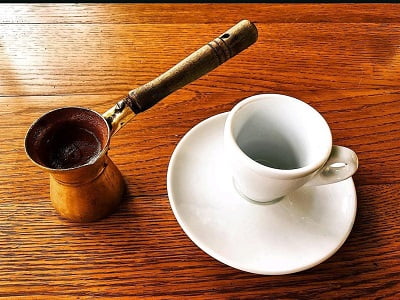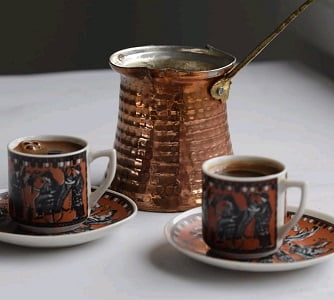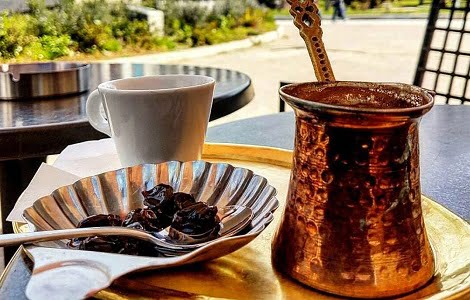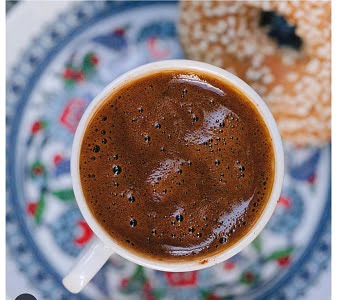Greek coffee is a strong and flavorful traditional coffee drink prepared by boiling fine coffee grounds with water and sugar in a special pot called a Briki. It has a thick texture and a really rich taste because the coffee grounds aren’t filtered. Plus, it’s topped with a rich foam called Kaimaki. In Greece, it’s more than just a drink—it’s a cultural staple, shared during social gatherings and celebrations.
If you’re a true coffee lover, Greek coffee is a must-try experience. Rich, bold, and unfiltered, it’s unlike any other coffee you’ve had.
Stick around as I discuss what Greek coffee is all about, how to make it, and what gives it that unique taste that keeps people coming back for more.

As an Amazon Associate, I earn commission from qualifying purchases.
How to Make Greek Coffee?
Here’s the Authentic Recipe for Traditional Greek Coffee!
What do you need to make Greek coffee?
To make Greek coffee, you need the following:
Briki (Bree-kee): A Briki is a tall, narrow pot with a long handle, traditionally made of copper, but aluminum or steel versions also work. The Briki is essential for making Greek coffee because its shape allows for slow, even heating, which helps develop the thick foam (Kaimaki) on top of the coffee, a key element of authentic Greek coffee.
Fine Coffee Grounds: Greek coffee requires very finely ground coffee, almost powder-like (even finer than Espresso grinds)
Small Demitasse Cups: Greek Coffee is traditionally served in small 1-2 oz espresso-sized cups.
Sugar (Optional): Greek Coffee can be made with sugar or without sugar. You can use white sugar or brown sugar to taste.

Here are some variations of Greek Coffee based on the amount of sugar you add
- Sketos (unsweetened): No Sugar Added
- Metrios (semi-sweet): One teaspoon of sugar.
- Glykos (sweet): Two teaspoons of sugar.
- Vary Glykos (very sweet): Three teaspoons of sugar
Step by Step Instructions
1- Add the Water
Fill a demitasse cup with cold water and pour it into the Briki. You’ll need around 60 mL of water per serving. The Briki is a small pot and you can only make 1-3 cups in it at a time.
2- Adding Coffee and Sugar
Put the Briki on low heat. Add the finely ground coffee powder to the water, using about two heaping teaspoons per demitasse cup of water. If you’d like, add sugar at this point. Give the mixture a quick stir to combine the ingredients, then let it heat undisturbed.
3- Allow Coffee to heat
Allow the mixture to heat slowly for 4-5 minutes. This slow heating process is key to developing the rich foam known as “kaimaki.” Keep a close eye on it and remove the heat when you start to notice small bubbles forming on the surface. After a brief pause, return the Briki to the heat and wait until you see the foam (kaimaki) rising to the top of the pot.
4- Pouring Technique
The way you pour affects the amount of foam in your cup. For thicker foam, pour the coffee from the Briki while holding it low and close to the cup. If you prefer less foam, pour from a little height. Distribute the foam evenly among the cups.
5- Serving and Enjoying
After pouring, let the coffee sit in the cups for about 3-4 minutes before drinking. This resting period allows the coffee grounds to settle at the bottom of the cup, resulting in a smoother drinking experience.

How to Serve Greek Coffee?
Greek coffee is traditionally served in small demitasse cups with a glass of cold water. Water is served to help cleanse the palate and small coffee grounds that might mingle in the mouth after drinking coffee.
The coffee is often enjoyed with sweets like cookies or cakes, adding a delightful complement to the intense taste of coffee. Traditionally, Greek coffee is served black without any milk. It’s also customary to sip the coffee loudly, a sign that you’re enjoying it.

Some Tips for the Greek Coffee Recipe
Never Fill Briki more than half
Here’s a crucial tip: don’t overfill your Briki! Always keep it under half full. Why? Well, Greek coffee needs room to bubble up and create that signature foam (kaimaki). If you fill it too much, you’ll end up with a mess on your stove and miss out on the perfect crema.
What are the best Coffee beans for Greek Coffee?
Good quality Arabica beans with Medium Roast is the best choice for Greek coffee. This gives the coffee a balanced flavor without being too strong.
It’s best to buy pre-ground coffee for this. I know, I know, freshly ground is usually the way to go. But Greek coffee needs an ultra-fine grind that’s hard to achieve with most home grinders.
I really like the Turkish brand Kurukahveci Mehmet Efendi. Its well calibrated grind size ensures optimal extraction, resulting in a smooth drink with the perfect thick consistency.
Can you Make Greek Coffee without Briki?
Yes, you can still make Greek coffee without a Briki. Your best bet is to use a small pot with a narrow opening. A regular saucepan is too wide – it won’t give you that nice foam on top. Instead, try something like a milk-frothing pitcher. It’s got the right shape to mimic a Briki.
Can you put Milk in the Greek Coffee?
Traditionally, Greek coffee is served without milk. The beauty of Greek coffee is in its simplicity – just coffee, water, and maybe some sugar. It’s all about savoring the strong, pure coffee flavor. But hey, it’s your cup of joe! If you want to add a splash of milk or cream, go for it.
What is the History of Greek Coffee
Greek coffee shares its roots with Turkish coffee and similar brews from the Balkans, Caucasus, Middle East, and North Africa. The exact origin of this coffee style is disputed, with many areas claiming its creation. Greek coffee likely arrived during the Ottoman Empire’s rule, first gaining popularity in northern Greece before spreading throughout the country.
Interestingly, the term “Greek coffee” itself has political undertones. Following the Turkish invasion of Cyprus in 1974, which strained Greek-Turkish relations, many Greeks began referring to the beverage as “Greek coffee” rather than “Turkish coffee.” This name change reflects how deeply this coffee style is embedded in Greek culture and identity.
Greek coffee culture also includes ancient traditions such as tasseography, where coffee grounds are used for fortune-telling, and the custom of pouring a bit of coffee on the ground to honor the deceased, a practice dating back to Ancient Greece.
Historically, coffee was introduced to Greece during the Ottoman Empire and became a popular social drink in cafes throughout the country by the 18th century. The practice of sipping Greek coffee slowly is central to social gatherings in Greece, often extending for over 2 hours.
Read a Guide on Turkish coffee
What’s the difference Between Greek Coffee and Turkish Coffee?
Greek coffee and Turkish coffee are essentially the same beverage, as are Armenian, Bosnian, Cypriot, and Serbian coffee. These variations all stem from the same preparation method and cultural tradition.
The main difference often cited is that Turkish coffee is typically boiled two to three times, while Greek coffee is usually boiled only once. However, this distinction is not universal and practices may vary across regions and individual preferences.
Read about other Coffee Drinks or Brew Methods
FAQs
Is Greek Coffee High In Caffeine?
Greek coffee contains about 40 mg of caffeine per 60 mL serving, which is relatively moderate compared to other brewing methods like espresso.
Do you drink the bottom of Greek coffee?
It’s best to leave the last sip of Greek coffee untouched, as it has a lot of coffee grounds. This sludgy residue can make the final sip gritty and unpleasant.
Greek Coffee Recipe
Equipment
- Briki
- Demitasse Cups
Ingredients
- 2 tsp Fine coffee grounds
- 60 mL Filtered Water
- 1-3 tsp Sugar (Optional)
Instructions
- Add the Water: Fill a demitasse cup with cold water and pour it into a briki. Use about 60 mL of water per serving.
- Add Coffee and Sugar: Place the briki on low heat. Add two heaping teaspoons of finely ground coffee per cup of water. Stir in sugar if desired, then let the mixture heat.
- Heat the Coffee: Heat the mixture slowly for 4-5 minutes until small bubbles form. Remove from heat when the foam (kaimaki) starts rising, then briefly return to heat to let the foam develop.
- Pour the Coffee: Pour the coffee into cups, keeping the briki low for thicker foam or slightly higher for less foam. Distribute the foam evenly among the cups.
- Serve and Enjoy: Let the coffee sit for 3-4 minutes to allow the grounds to settle before drinking. This ensures a smoother experience.




